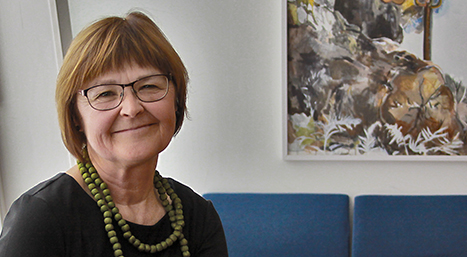Denna nyhet är äldre än 6 månader och är kanske inte aktuell längre.
Mathematics is present in children's play

Early childhood education at the preschool level is necessary, but staff must have the knowledge to be able to meet children at their own level, says Kerstin Bäckman researcher at Gävle University.
“As early as at the preschool level it is important, to confront the child’s curiosity for mathematics,” says Kerstin Bäckman.
She has investigated how children use mathematics in preschool, and how preschool teachers shape education with a mathematical content.
She has observed and subsequently analysed the play of four year olds and described its mathematical content. She has also interviewed preschool teachers in order to gain an understanding of the knowledge demanded in teaching.
Mathematics occurs in play
“Mathematical development often runs parallel to language development during childhood.”
Positioning is a concept within child development that is connected to the area of geometry; body awareness and spatial awareness are other areas.
She has only observed everyday activities such as children playing football, cycling, playing in the sandpit or outside in the grounds of the playschool.
”When they played football I could see how they reacted regarding mathematical positioning. On other occasions, when they scooped up sand and emptied it out, how they investigated and made comparisons regarding volume.”
To make visible rather than to practice
”It is more about making things visible than creating opportunities for practice.”
The children play and perhaps experience the concept of volume, but they are not maybe aware that it is volume, it is the game that is crucial for the children.
”The preschool teachers can make use of the opportunity and together with the children make visible the concept of volume, if they have the knowledge.
Or if the children are presented with inspirational material; a table full of different coloured buttons for example. Then it is up to the teacher to try and see when children for example create a pattern. Then the teacher can comment “Look you have made a pattern, blue, green, blue, green.” In other words the children did something and the preschool teacher made it explicit.”
“If the preschool teacher has the mathematical understanding they can make use of the opportunity”
The same focus as the children
It has been shown that it is important that one, as a teacher, has the same focus as the children; that one is in the here and now, not on the way somewhere else. And that one tries to demarcate the learning of the actual concept that one wants the children to see.
The preschool teachers want to capture the spontaneous learning opportunity, perhaps make a game or participate themselves in a game.
”Look, they are investigating volume; I could go in and direct their attention towards volume, by naming concepts.
To know what to use
One thing that was made apparent in the interviews with the preschool teachers was the importance of knowing what there is in the environment that one can use.
“If I am going to teach numbers and place value I can use this material. That one knows what material is available.
Another thing was the teachers’own mathematical understanding. Both for themselves to be able to discern what the children were doing and also knowing what to do to provide a challenge for the children in their knowledge of mathematics.
”That I as teacher have the understanding for what the next level could be and what learning might take place.”
Surprised
One thing that was surprising was that mathematical content was present in all children’s ordinary everyday play. Mathematics is there when they play football or when they cycle round and round and then maybe park their cycle.
“On that occasion special awareness is involved; where one should place the cycle in relation to others.”
Another thing that was surprising was that the children were so engaged in their interaction with the preschool teacher.
”A kind of silent didactic contract can be observed.”
Kerstin Bäckman hopes that her research can contribute towards improving the training of preschool teachers.
“The work of preschool teachers was impressive, it made a strong impression on me,” concluded Kerstin Bäckman.
Kerstin Bäckman defends her doctor’s thesis on the 29th Januari, 16.00 in Jakobstad, Finland, with the thesis ”Children’s play as a starting point for teaching mathematics in preschool”.
Christina Gustafsson, Professor of Pedagogy at the Department of Educational Sciences at Gävle University and Marita Lindahl Professor Emeritus at Åbo Akademi University, Finland.
For further information contact:
Kerstin Bäckman, University lecturer in Didactics at Gävle University Tel: 026-648553, 070-213 36 57 E-mail: kerstin.backman@hig.se
Text: Douglas Öhrbom
Foto: Ove Wall






 Utskriftsversion
Utskriftsversion